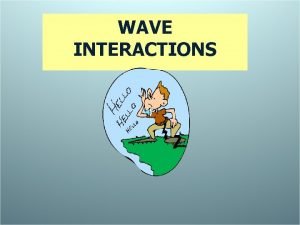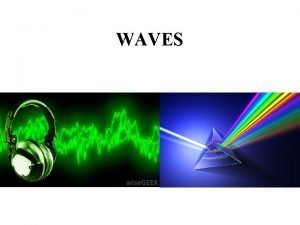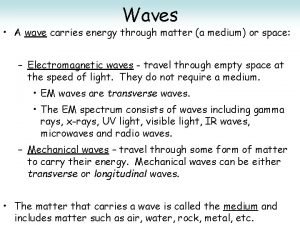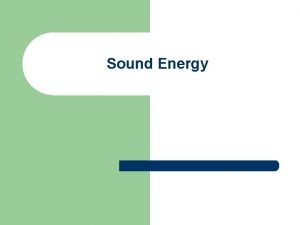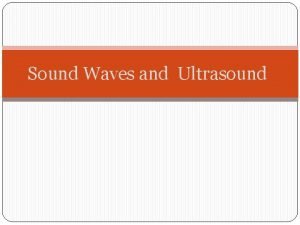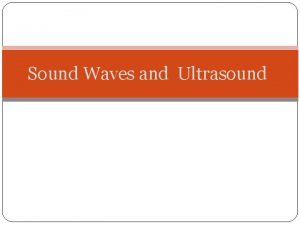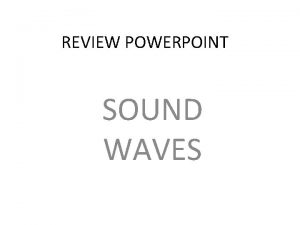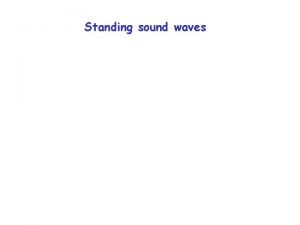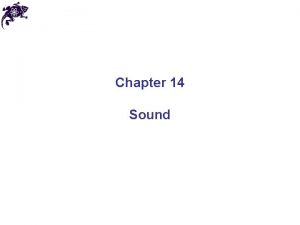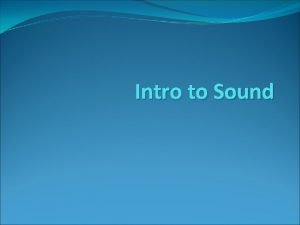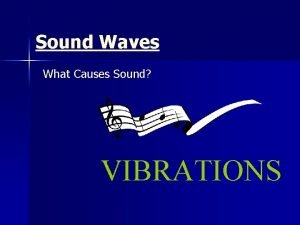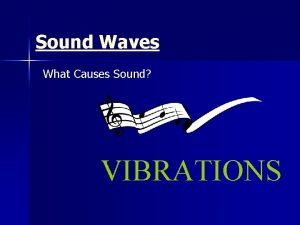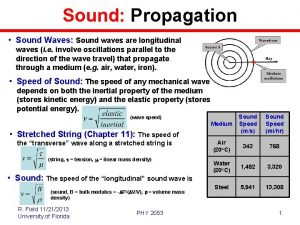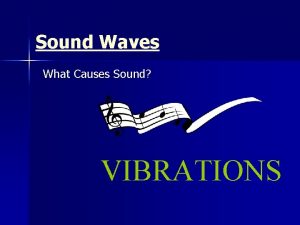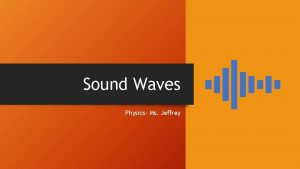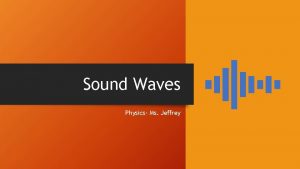SOUND REVIEW Waves transport ENERGY not matter Waves




















- Slides: 20

SOUND

REVIEW ü Waves transport ENERGY, not matter. ü Waves are mechanical (matter) or non-mechanical (no matter). ü Sound is mechanical. ü Light is non-mechanical. Transmission of Sound

SOUND WAVES Sound waves are compressional waves. n The vibrations of the molecules are parallel to the direction of the wave. n Produced by the compressions and rarefactions of matter. n

SOUND WAVES LABEL YOUR DIAGRAM

SOUND WAVES n n Sound is produced by a vibrating object. As one individual particle is disturbed, it transmits the disturbance to the next interconnected particle. This disturbance continues to be passed on to the next particle. The result is that energy is transported without the actual transport of matter.

SOUND WAVES Visualizing Sound

SPEED OF SOUND Speed depends upon how fast one particle can transfer its motion to another particle. n Speed of sound depends on the n Elasticity n Medium (Density) n Temperature n

SPEED OF SOUND n ELASTICITY n the ability of an object to bounce back to its original shape. n Sound travels faster in more elastic objects. n Typically gases are the least elastic, liquids are next and solids are the most elastic. Example: A rubber band is more elastic than modeling clay – it bounces back into shape whereas modeling clay stays stretched.

SPEED OF SOUND n DENSITY n generally speaking, in material of the same state of matter (solid, liquid or gas) the denser the medium, the slower the sound travels. n Sound travels slower in lead than it does in steel.

SPEED OF SOUND

SPEED OF SOUND n TEMPERATURE n Generally speaking the higher the temperature, the faster the speed of sound. n Since the molecules vibrate faster, sound waves can travel more quickly.

SPEED OF SOUND n Speed of Sound – on average Air (22°C): 346 m/s (765 mph) – about 1 mile per 5 s. n Air (0°C): 331 m/s (740 mph). n Water is 1, 482 m/s(3, 315 mph) about 1 mile per 1. 1 s. n Steel is 5, 960 m/s(13, 330 mph) about 1 mile per 0. 27 s or 3. 7 mile per 1 s. n

SPEED OF SOUND LIGHNING VS THUNDER, LIGHT VS SOUND § You see a flash of lightning across the sky. Five seconds later, you hear a rumble of thunder. § They occur at the same time. However, light travels extremely fast (300, 000 m/s) and sound much slower (343 m/s). § Sound has a disadvantage because it tends to bounce off molecules in the sir. This makes sound travel in all different directions. The further away the source of the sound it, the more sound gets distorted. § So if the thunder is rumbling, the lightning was far away. If the thunder cracked or boomed, the lightning bolt was close to you (less than 100 m)

BREAKING THE SOUND BARRIER n n Chuck Yeager – first man to fly faster than the speed of sound Andy Green – first man to drive a land vehicle faster than the speed of sound. October 14, 1947 – in X 1 “Glamorous Glennis” October 15, 1997 – in Super. Sonic Car “Thrust SSC” 763 MPH

HOW WE HEAR

HOW WE HEAR When a sound wave reaches the ear, a series of high and low pressure regions hit the eardrum. n The arrival of a compression or high pressure region pushes the eardrum inward; the arrival of a low pressure region serves to “pull” the eardrum outward. n The continuous arrival of high and low pressure region sets the eardrum into motion. n

HOW WE HEAR n n n Auricle (Pinna-the ear flap) – used to focus the sound waves into the ear canal Ear Canal (Auditory Canal) – focuses the sound onto the ear drum. Ear Drum (Tympanic membrane) – Sound starts the ear drum vibrating.

HOW WE HEAR n Three smallest bones vibrate, one after the next. n Hammer (Malleus) is touching the ear drum & vibrates first. n Next is the Anvil (Incus). n Last is the Stirrup (Stapes). n Eustachian Tube: tube that connects the middle ear with the throat. This allows the pressure on both sides of the ear drum to equalize.

HOW WE HEAR n n n The Stirrup vibrates the oval window of the cochlea. Cochlea is a long fluid filled tube, folded in half and the coiled up like a snail shell. The entire inner surface is lined with cilia, little hairs. Once cilia are vibrated, the attached nerves are stimulated • and send signal to the brain. Balance is achieved by the semicircular canals. • Three canals in three different planes are able to determine the body’s position in

HOW WE HEAR Need to know these structures & their function: Outer Ear, Middle Ear, Inner Ear, Auricle, Ear canal, Ear drum, Hammer, Anvil, Stirrup, Oval Window, Cochlea, Auditory Nerve, Semicircular Canals, Eustachian Tube. How We Hear
 Difference between matter waves and electromagnetic waves
Difference between matter waves and electromagnetic waves Sound waves are electromagnetic waves true or false
Sound waves are electromagnetic waves true or false How are rainbows made
How are rainbows made The wave chapter 13
The wave chapter 13 Is echolocation transverse or longitudinal
Is echolocation transverse or longitudinal Energy naturally flows from warmer matter to cooler matter.
Energy naturally flows from warmer matter to cooler matter. Waves transfer energy without transferring
Waves transfer energy without transferring A disturbance that transfers energy
A disturbance that transfers energy A wave carries
A wave carries Mechanical wave and electromagnetic wave
Mechanical wave and electromagnetic wave Kesler science properties of waves answer key
Kesler science properties of waves answer key Sound waves energy
Sound waves energy Sadlier vocabulary workshop level d unit 1 synonyms
Sadlier vocabulary workshop level d unit 1 synonyms Symport antiport uniport
Symport antiport uniport Active transport
Active transport Passive transport vs active transport venn diagram
Passive transport vs active transport venn diagram Active vs passive transport venn diagram
Active vs passive transport venn diagram Pinocytosis vs phagocytosis
Pinocytosis vs phagocytosis Primary active transport vs secondary active transport
Primary active transport vs secondary active transport Bioflix activity membrane transport active transport
Bioflix activity membrane transport active transport Active and passive transport
Active and passive transport






